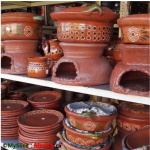
The firefly family, Lampyridae , counts with around 2,100 species. Best known for their glow at night, fireflies, or luciérnagas, in Spanish, are a sure sign of summer. Less known is that they are not flies but beetles, and are a great natural pest control; the female adults deposit their eggs in the ground, where their larvae feed on worms and slugs.
In the Mexican state of Tlaxcala, in the municipalities of Nanacamilpa and Españita, there is El Santuario de las luciérnagas– The Firefly Sanctuary, where thousands of fireflies arrive in the summer months, to mate (photo below from Wikipedia Commons):
Equally large is the peregrination of people wanting to witness this unique concert of lights every year.
I have never been there, or seen a luciérnaga in Mexico; here in Canada, I am still fascinated by them (photo at the top of this post), particularly when I see them glowing at night, right in my backyard:
Tlaxcala is the smallest state in Mexico, located in the Central region of the country. In spite of its size of 3,991 km² (1,540.9 sq mi), accounting for merely 0.2% of Mexico’s total surface area, its municipal division adds up to 60, and each one has many attractive features, rich in culture and culinary delights.
In addition to the Firefly Sanctuary in Nanacamilpa and Españita, for example, La Malinche is an active volcano surrounded by ashes and a large forest, part of Malinche National Park. To maintain the park, many municipalities are responsible, four in the neighbouring state of Puebla, and twelve in Tlaxcala, namely: Acuamanala, Chiautempan, Contla, Huamantla, Ixtenco, Mazatecochco, San Francisco Tetlanohcan, San José Teacalco, San Pablo del monte, Santa Cruz Tlaxcala, San Luis Teolocholco y Zitlaltepec. There are also four archaeological zones in the state: Tecoaque, in the municipality of Calpulalpan; Tizatlán in the municipality of Tlaxcala; Ocotetulco in the municipality of Totolac; and Cacaxtla in the municipality of Nativitas.
Tlaxcala has vast maguey fields, particularly in the municipality of Tlaxco, established as a top producer of pulque, a pre-Hispanic beverage; the municipality of Tocatlán is famous for its chicken, wrapped in maguey film. Huamantla and Ixtenco are famous for their local moles, such as “matuma de ladrillo” made with guajillo peppers and seasoned with cloves, cinnamon and coriander seed. Although this and other delicious dishes might be served with some Tlaxcala style rice, of course the staple across their state is their artisan tortillas; white, yellow, blue or red corn are cultivated, then nixtamalized (cooked in lime salt) and ground to prepare masa (corn dough) in many colourful ways. The word “tortilla“, as I have mentioned before, is a Spanish term to describe flat concoctions, such as an egg omelette; the Nahuatl (pre-Hispanic) word for them is tlaxcalli, and according to many historians, it is the origin of Tlaxcala’s name, from Tlaxcallān – place of corn bread, from Classical Nahuatl tlaxcalli – corn bread (“tortilla”) and tlān – place. Stay tuned for more on this, in my next posts.









thanks for the good news about fireflies!
LikeLiked by 1 person
We had so many fireflies growing up in New Jersey. Down here in Florida? Not a single one. They were one of the joyful wonders of my childhood.
LikeLiked by 1 person